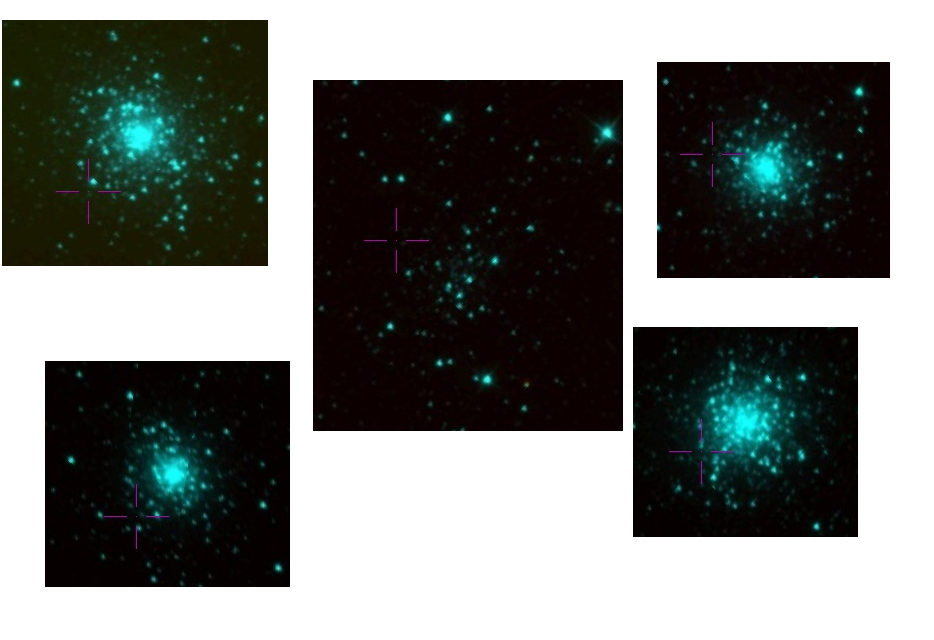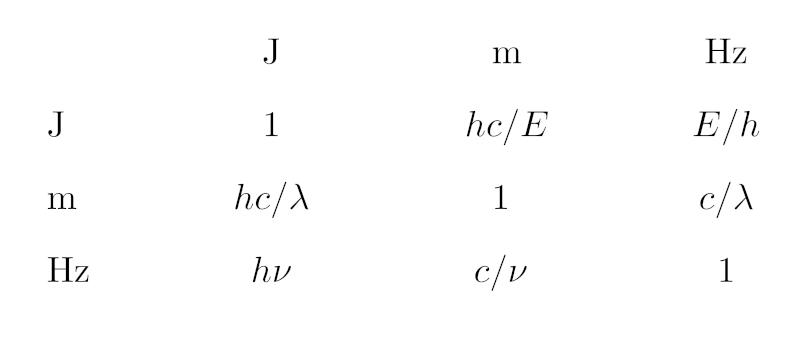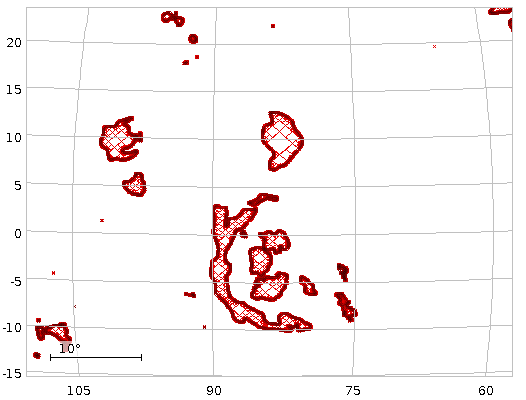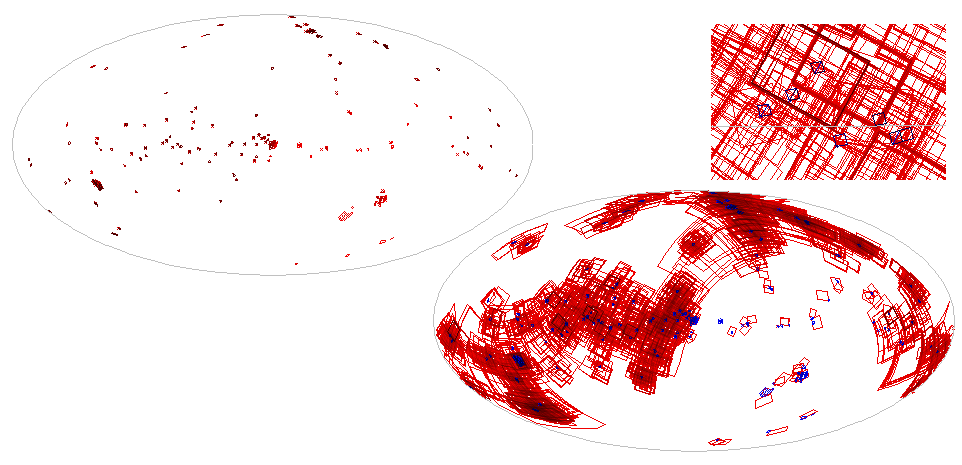A Proposed Vector Extension for ADQL
When I showed off my rendering of the Gaia DR 3 XP spectra a month ago, I promised I would later show how my proposal for a Vector extension to ADQL would enable quite a bit of interesting functionality on that table. Let me make good on this promise with a little project to find candidates for Wolf-Rayet stars, more specifically, WC stars. I give you that's a bit cheap because they have very distinctive spectral features, but then this is supposed to be a quick educational posting, not a science paper.
Before I start, I probably should stress that in this context I am using the word “vector” like a computer guy would. We are talking about one-dimensional arrays here, not about the vectors the mathematicians have given us (as in “elements of vector spaces“).
Getting Spectra for Wolf-Rayet Stars
Let us first produce a list of Wolf-Rayet stars (of any denomination) using SIMBAD. So, start TOPCAT, open the TAP dialog and find the SIMBAD TAP server. Run:
SELECT main_id, ra, dec FROM basic WHERE otype='WR*'
there[1]. In the next step, we will need the Gaia DR3 source_ids for these objects, and so it would be nice to pull them immediately from Simbad; you could in principle do that by running:
SELECT main_id, ra, dec, id FROM basic JOIN ident ON (oid=oidref) WHERE otype='WR*' AND id LIKE 'Gaia DR3%'
– but for one, fiddling out the actual source_ids from the strings you get in the id column is a bit tedious, and then quite a few of these objects don't have Gaia ids yet: The first query returns 1548 at the moment, the second 696.
If we had the source_ids, we could immediately join with the gdr3spec.spectra table at the GAVO DC TAP (http://dc.g-vo.org/tap). As I mentioned a month ago, this is a physical table just consisting of the source id and arrays of flux and flux errors. There is also gdr3spec.withpos that has positions and the spectra; but that's a view, and for the time being that means that the planner will quite likely get confused when positional constraints come into play[2]. The result would be queries running for half an hour when a few seconds would do just as well.
On services already supporting ADQL 2.1, you can usually work around problems of this kind by re-writing your query to use CTEs (“WITH”), because these often work as planner barriers. In the present case, we first get source_ids for our Simbad objects in a CTE and then use these to join with our spectra table, like this:
WITH wrids AS (
SELECT source_id, main_id
FROM gaia.edr3lite AS l
JOIN tap_upload.t1 AS u
ON (DISTANCE(l.ra, l.dec, u.ra, u.dec)<0.001))
SELECT main_id, source_id, flux, flux_error
FROM gdr3spec.spectra
JOIN wrids USING (source_id)
As usual, you will probably have to adapt the number in what is tap_upload.t1 here to the table index you have for your SIMBAD result.
This yields 574 spectra at the moment, within a few seconds. Spectra for about a third of our collection of objects: I'd say that's quite impressive.
Investigating the spectra
The September post already discussed a few aspects of array plotting. In short: try the plane plot and an XYArray control. Modern TOPCATs (and for what I'm doing here it's wise to use something newer than 4.8-7) will automatically figure out suitable columns for the x and y axes (except it forgets to label the spectral coordinate with its unit, nm):
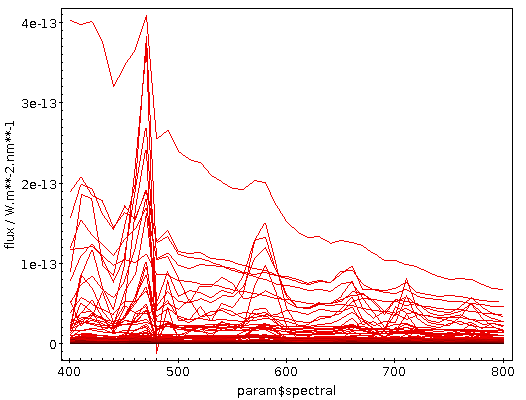
There's a quite a bit of crowding here; finding global characteristics perhaps works better when you switch the ordinate to logarithmic, use transparent shading (in the Form tab) and raise the opaque limit a bit. This could give you something like:
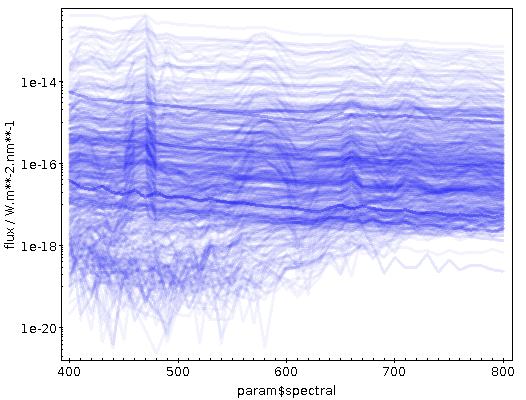
You can see that at least quite a few objects have nice and strong emission lines, as I had hoped for when choosing WC stars for this example. What if we could pick them out to build a template spectrum? Well, let's try. With the new vector math in ADQL, the database can normalise the spectra and compute a few statistics on them.
But first: In order to get rid of the source_id-computing CTE above, let me obtain the source_ids I want to work with once and for all, as in:
SELECT source_id, main_id
FROM gaia.edr3lite AS l
JOIN tap_upload.t1 AS u
ON (DISTANCE(l.ra, l.dec, u.ra, u.dec)<0.001)
Memorise the Table List index of the result. With that, you can directly work with the gdr3spec.spectra table and experiment a bit; for me, the index was 10, and hence I use tap_uploads.t10 below.
Computing some statistics
The Gaia XP spectra are flux calibrated, and hence I will have to normalise them if I want to compare them. Ignoring all errors and thus in particular the fact that some (few) components are negative, this normalisation is harmless: We just divide by the sum of all vector components. The net result is that, were our spectra continuous, the integral over them would be one. And let's then use the standard deviation and the value of the 19th array element as metrics:
WITH normalised AS (
SELECT source_id, main_id,
flux/arr_sum(flux) as nflux, flux
FROM gdr3spec.spectra
JOIN tap_upload.t10
USING (source_id))
SELECT
source_id, main_id,
flux, nflux,
arr_avg(nflux*nflux)-POWER(arr_avg(nflux),2) AS sd,
nflux[19] as em
FROM normalised
You can see quite a bit of the vector extension here:
- arr_sum and arr_avg: These work as the aggregate functions in SQL do, just not on tuples but on the components of the vectors.
- Multiplication of vectors is element-wise, so nflux*nflux computes a vector of the squares of the components of nflux. That's also true for all other basic arithmetic operators. If you know numpy: same thing.
- You fetch individual elements in the [] notation you probably know from Python or C. Contrary to Python and C, common SQL implementations count indexes from 1 by default, and we are keeping that here (for now). Fortran lovers rejoice!
Why did I use nflux[19]? Well, there is a reasonably strong emission feature in many spectra at about 580 nm (it's three-time ionised carbon, or C IV in the rotten notation I usually apologise for when talking to non-astronomers), which is, as experts tell me (thanks, Andreas!), rather characteristic for the WC stars that I'm after (whereas the even stronger feature on the left, around 470 nm, can also be Helium).
If you inspect the spectral coordinate that TOPCAT has on the abscissa (it's a param, so you'll have to go to Views → Table Parameters to see it), you will see that each spectral bin is 10 nm wide. So, I will hopefully hit the 580 nm feature when fetching the 19th element of the spectral vector.
If you plot em versus the sd obtained like that, you will see two reasonably distinct groups, where the ascending arm has relatively strong emission around 580 nm and the descending arm does not. I have used the Blob subset feature to select the upper arm into a subset ”upper” that is blue in the following plot. If you click around in the em-sd plot and show the Activated subset in an array plot, you can see things like:
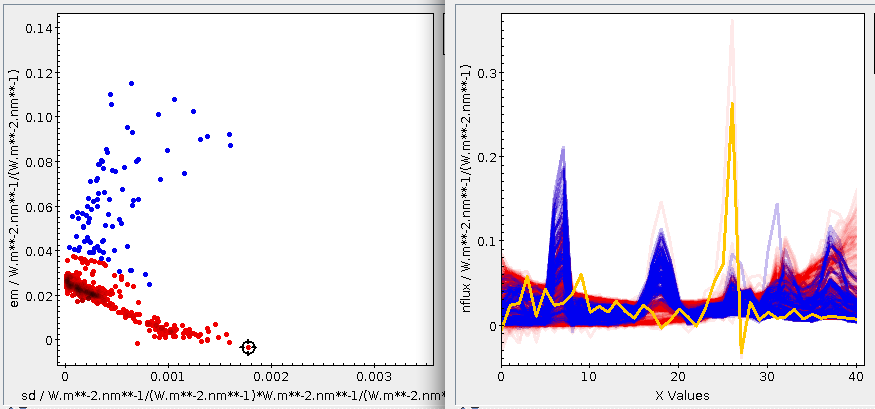
The activated spectrum (shown here in yellow) has a strong Hα but basically no C IV – and it's safely outside of our carbon subset. Click around a bit on the ascending arm, and you will see that all these spectra have a bump around array element 18 (in TOPCAT's count, which starts at 0).
Computing a Template on the Server Side
Whatever the subset of stars that we would like to use to define our group of interest, we would now like to create a template spectrum from them. A plausible way to do that is to sum them all up – that has the nice side effect that stronger sources (which hopefully are less noisy) have a larger weight.
To compute the template, in the Views → Column Info for the sd/em table, unselect all columns but source_id (that way, you only upload what you absolutely must), and in the main window, select the upper subset in the Row Subset combo box. That way, only the rows in that subset will get uploaded in the following query:
SELECT summed/arr_sum(summed) AS tpl FROM ( SELECT SUM(flux) AS summed FROM gdr3spec.spectra JOIN tap_upload.t19 USING (source_id)) AS q
Again, you will have to adapt the t19 to where your manipulated sd/em table is. If you get an “ambiguous column flux” error (or so) here, you forgot to unselect all columns but source_id in the columns window.
It pays to briefly appreciate what happens here: The SELECT SUM(flux) is an aggregate function over arrays, meaning that all the arrays are being summed over component-wise. Against that, the sum in summed/arr_sum(summed) is summing within the array. If it helps you, you could imagine having all the arrays in the table stacked. Then, SUM(arr) produces the vertical margin sum, and array_sum(arr) procudes the horizontal margin sum.
Well, here's the template I got in this way:
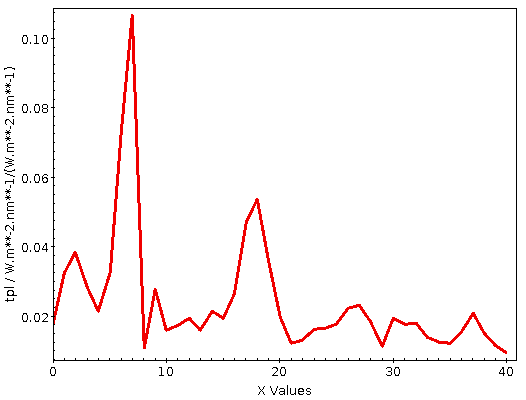
I give you that in this particular case, you could easily have done the computation on the client side, because you already had the spectra in your table. But the technique also works when you don't, and it will scale to millions of arrays (although you will have to carefully think about numerics when doing such enormous sums).
Also – I cannot lie – I simply had to have a pretext for showing you aggregate functions over arrays.
Finding Similar Objects
Now that we have the template, can we find objects that have similar properties? Sure: We upload the array and compute some metric, perhaps the (squared) euclidian distances to normalised spectra. If the template is in TOPCAT's table 25, you can write:
SELECT TOP 200000
source_id,
arr_sum(
arr_map(
power(x,2),tpl-flux/arr_sum(flux))) AS dist2,
arr_sum(flux_error/flux) AS errs
FROM gdr3spec.spectra, tap_upload.t25
This will compute the distances between (conceptually randomly drawn) 200000 spectra and your template. I am also requesting the sum of the (relative) flux errors as a measure of how likely it is that wild wiggles actually are just artefacts.
There is one array-related feature in that query I have not yet mentioned: arr_map. This applies an expression to all components to a vector, pretty much like python's map function, and my attempt to have some (perhaps somewhat lame) substitute for numpy's ufunctions.
I am rather sure we really need something like this. SQL has no notion of defining functions in queries. That is usually welcome, as otherwise it would quicky become Turing-complete, which would be bad for what it is designed to do. Here, however, that is a problem, because we do not have a clean way to write the expression be be computed for each component. For now, I have decreed that the first argument of map is an expression over a formal x. This is ugly not only because it will be confusing when there's an actual x in a table or query. I suspect with a bit more thought and creativity, one can find a better solution that still does not require a re-write of half the SQL grammar. But then let's see – perhaps this makeshift hack proves to be less troublesome than I expect.
Note that on my server, you will only get back 20000 matches by default; you would have to adapt Max Rows to actually retrieve 200'000, and then you also must switch to Asynchronous mode. This will then actually take a non-trivial amount of CPU and disk I/O; going through the entire set of 2e8 rows will be a matter of hours or so. Hence, I'm grateful if you do all-sky scans only after having tested your queries on much smaller subsets.
I've done this for 500'000 rows (which took a few minutes), which might bring up a few C IV-strong WR stars (these beasts are rare, you know). The result in the dist2/errs plane is (logplot zoomed a bit):
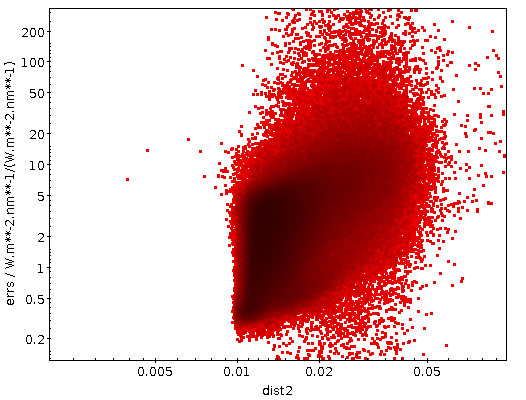
Well: at least there are a few promising cases. Which would conclude this little demo for the ADQL vector proposal. Looking at what we have found here is another story.
Still, I could not resist having another look at what my box has found there. There is a rather clear cut in the plot at perhaps 0.009, and thus I created a subset interesting consisting of objects for which dist2<0.009 (which is 18 objects for me) and did the trick above, only uploading this interesting subset with only the source_id column to resolve to Gaia DR3 (lite) rows:
SELECT * FROM gaia.dr3lite JOIN tap_upload.t33 USING (source_id)
And then I wondered whether any of these were known to SIMBAD and switched to their TAP service:
SELECT
tc.*, otype
FROM basic AS db
RIGHT OUTER JOIN TAP_UPLOAD.t34 AS tc
ON 1=CONTAINS(POINT('ICRS', db.ra, db.dec),
CIRCLE('ICRS', tc.ra, tc.dec, 1./3600.))
Note the use of RIGHT OUTER JOIN to ensure we won't lose any matches on the way; if this weren't such a small table, you'd be better off just uploading the positions and then doing a local match to recover the rest of the table, by the way.
As to what's coming back: Well, a bunch of white dwarf candidates, a “blue“ star, a few objects SIMBAD knows as quasars (that at least makes sense, because it's rather likely that some of them have lines redshifted into my C IV window), and a few unclassified objects. Whether SIMBAD is wrong on at least some of them, whether the positional crossmatch fetched unrelated objects, or whether I got it all wrong I will not decide here. Let me give you my candidates as a VOTable, though.
You now know what you have to do to add nice, if low-resolution, spectra to them.
Slices?
A notable absence from the current vector extension is slicing. I think we should have it – in this example, this would be really useful when summing different spectral regions without having to write long sums (“synthetic broadband photometry“).
I have not put it in yet mainly because I am not sure if Python-like syntax (nflux[4:7]) is a good idea when we have 1-based arrays. Also: Do we want to keep the upper index out? That's certainly the right thing for Python (where you want a[:3]+a[3:] == a), but is it here? Speaking of which: Should we require support of half-open slices? Should we rather have a function arr_slice? With what arguments?
I'd be curious about other peoples' thoughts on slicing.
| [1] | In case you wonder how I came up with the WR*: You can simply run something like: SELECT otype, label FROM otypedef WHERE description LIKE '%Wolf%' Once Simbad upgrades to ADQL 2.1, you probably want to replace the LIKE with ILIKE for robustness. |
| [2] | For the incurably curious, you can learn more about the underlying problem at https://github.com/segasai/q3c/issues/30. |

![[RSS]](../theme/image/rss.png)
